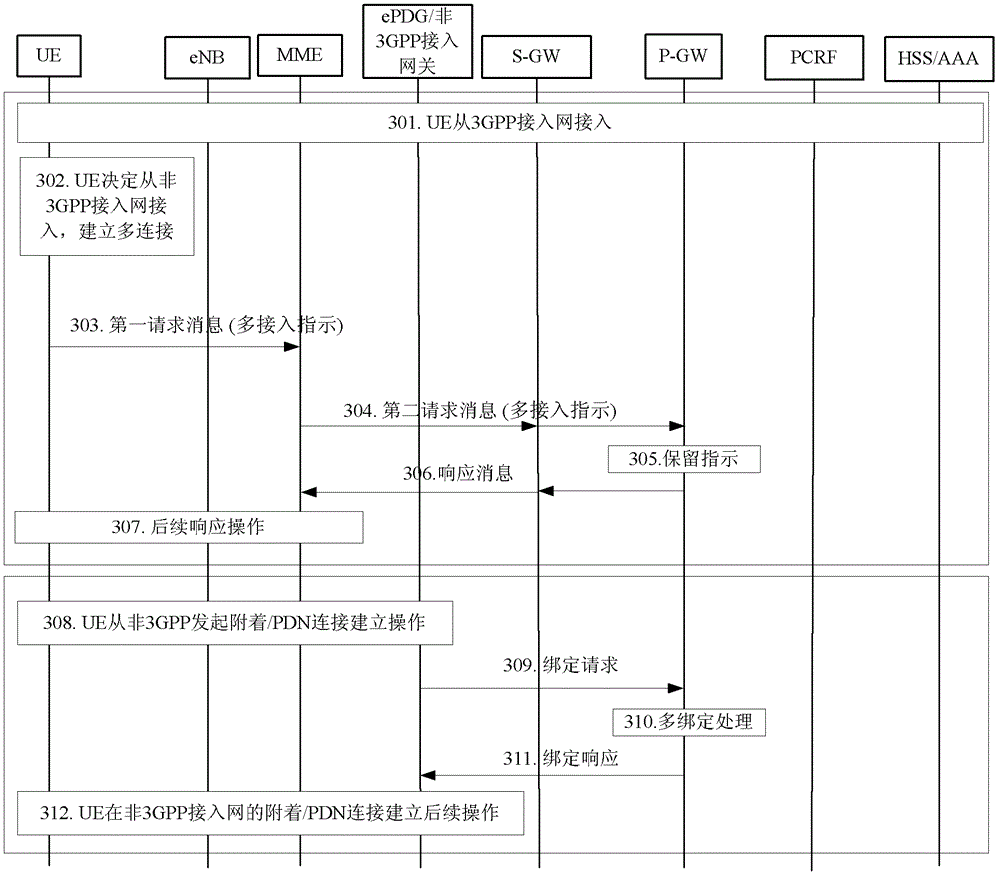A multi-access method and system
A multi-access and access network technology, applied in access restrictions, connection management, electrical components, etc., can solve problems such as the difficulty of formulating unified standards, and achieve the effect of avoiding influence and modification
- Summary
- Abstract
- Description
- Claims
- Application Information
AI Technical Summary
Problems solved by technology
Method used
Image
Examples
Embodiment 1
[0059] see figure 2 The flow shown in this embodiment is based on the scenario where the S5 / 8 interface, the S2a interface between the non-3GPP access gateway and the P-GW, and the S2b interface between the ePDG and the P-GW all use the GTP protocol. The specific steps are described as follows:
[0060] Step 201: The UE decides to attach to the EPC through the 3GPP access network, and then initiates an attach establishment operation; or after the UE has access to the EPC network, wants to establish an additional PDN connection (additional PDN connection), then initiates a PDN connection establishment operation.
[0061] Step 202: The UE sends an attach request / PDN connection establishment request to the MME, and carries a "multi-access indication" in the message.
[0062] Step 203: the UE requests the HSS / AAA to perform user access authentication through the MME.
[0063] Step 204: The MME sends a "session creation request" message to the S-GW, and the S-GW sends a "session...
Embodiment 2
[0078] This embodiment is basically the same as the first embodiment above, the main difference between them is that the S5 / 8, S2a, and S2b interfaces can adopt the PMIPv6 protocol. figure 2 The messages in steps 204 and 206 and steps 209 and 211 in the process may be PMIPv6 protocol messages, or a pair of messages of PBU (Proxy Binding Update, Proxy Binding Update) and PBA (Proxy Binding Acknowledgment, Proxy Binding Acknowledgment). That is: steps 204 and 206, steps 209 and 211 are either PMIP messages, or GTP messages (i.e. embodiment one); or steps 204 and 206 are GTP messages, and steps 209 and 211 are PMIP messages, or steps 204 and 211 are PMIP messages. 206 is a PMIP message, and steps 209 and 211 are GTP messages.
[0079] The following embodiments are also similar, that is, as long as the S5 / 8 interface, or the S2a interface, or the S2b interface is involved, the GTP protocol and the PMIPv6 protocol can be used.
Embodiment 3
[0081] The difference between this embodiment and the foregoing embodiment 1 and embodiment 2 is that in embodiment 1 and embodiment 2, when the terminal UE attaches to the 3GPP network or establishes a PDN connection from the 3GPP network, it sends a multi-access indication to the P- GW, but in this embodiment, the multi-access instruction is sent from the 3GPP access network to the P-GW before the terminal initiates a non-3GPP access, and the P-GW receives the instruction and determines It is currently a multi-access scenario. Afterwards, as long as the P-GW receives a binding request from a non-3GPP access network gateway or ePDG, the P-GW will perform multi-binding.
[0082] Such as image 3 As shown, the specific steps of the process are described as follows:
[0083] Step 301: The UE has attached to the EPC through the 3GPP access network, and may have established one or more PDN connections.
[0084] Different from the foregoing embodiments, in this embodiment, when t...
PUM
 Login to View More
Login to View More Abstract
Description
Claims
Application Information
 Login to View More
Login to View More - R&D
- Intellectual Property
- Life Sciences
- Materials
- Tech Scout
- Unparalleled Data Quality
- Higher Quality Content
- 60% Fewer Hallucinations
Browse by: Latest US Patents, China's latest patents, Technical Efficacy Thesaurus, Application Domain, Technology Topic, Popular Technical Reports.
© 2025 PatSnap. All rights reserved.Legal|Privacy policy|Modern Slavery Act Transparency Statement|Sitemap|About US| Contact US: help@patsnap.com



